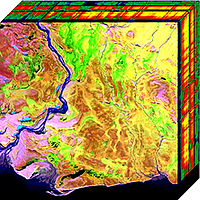
Photo from wikipedia
The two-step approach (TSA) is an efficient full-aperture method to solve the Doppler spectrum aliasing when processing data acquired by a synthetic aperture radar (SAR) system operating in beam steering… Click to show full abstract
The two-step approach (TSA) is an efficient full-aperture method to solve the Doppler spectrum aliasing when processing data acquired by a synthetic aperture radar (SAR) system operating in beam steering mode. This simple approach solves the spectral aliasing by implementing an azimuth convolution between the raw data and a chirp signal, thus avoiding complex subaperture division and recombination of subaperture approaches. However, as aliasing reoccurs in the slow time-domain after the convolution, the estimation and compensation for residual motion error by autofocus cannot be performed immediately, which is crucial for airborne and high-resolution spaceborne SAR processing. The extended TSA solves this problem by implementing full-aperture azimuth scaling, but it is inefficient when the scaling factor deviates from unity severely, which is common in the data acquisition geometry of an airborne SAR. Aiming at addressing the existing shortcomings, this article combines the TSA with autofocus by the time-domain dealiasing and provides an efficient full-aperture processing framework of airborne spotlight SAR data. Simulated and experimental airborne spotlight SAR data with the transmission signal bandwidth of 1.2 GHz and a coherent integration angle of 15$^\circ$ are processed by the proposed algorithm and the clarity of the processed results shows its effectiveness.
Journal Title: IEEE Journal of Selected Topics in Applied Earth Observations and Remote Sensing
Year Published: 2022
Link to full text (if available)
Share on Social Media: Sign Up to like & get
recommendations!